Gryon
Gryon is a municipality of the canton of Vaud in Switzerland, located in the district of Aigle.
Gryon | |
|---|---|
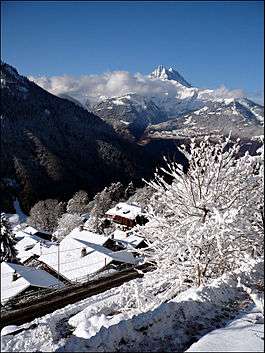 Gryon village | |
.svg.png) Coat of arms | |
Location of Gryon 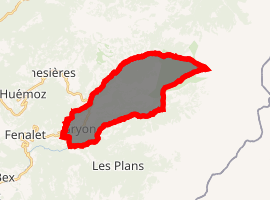
| |
 Gryon  Gryon | |
| Coordinates: 46°16′N 7°04′E | |
| Country | Switzerland |
| Canton | Vaud |
| District | Aigle |
| Government | |
| • Mayor | Syndic Robert Jaggi |
| Area | |
| • Total | 15.22 km2 (5.88 sq mi) |
| Elevation | 1,114 m (3,655 ft) |
| Population (2018-12-31)[2] | |
| • Total | 1,332 |
| • Density | 88/km2 (230/sq mi) |
| Demonym(s) | Les Tachis |
| Postal code | 1882 |
| SFOS number | 5405 |
| Localities | La Barboleusaz, Les Pars |
| Surrounded by | Ollon, Ormont-Dessus, Bex |
| Website | www Profile (in French), SFSO statistics |
History
Gryon is first mentioned in 1189 as Griuns.[3]
Geography

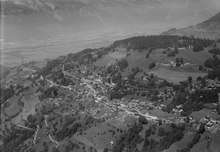
Gryon has an area, as of 2009, of 15.22 square kilometers (5.88 sq mi). Of this area, 4.31 km2 (1.66 sq mi) or 28.3% is used for agricultural purposes, while 7.96 km2 (3.07 sq mi) or 52.3% is forested. Of the rest of the land, 1.71 km2 (0.66 sq mi) or 11.2% is settled (buildings or roads), 0.07 km2 (17 acres) or 0.5% is either rivers or lakes and 1.19 km2 (0.46 sq mi) or 7.8% is unproductive land.[4]
Of the built up area, housing and buildings made up 7.9% and transportation infrastructure made up 2.9%. Out of the forested land, 42.1% of the total land area is heavily forested and 4.2% is covered with orchards or small clusters of trees. Of the agricultural land, 0.0% is used for growing crops and 7.0% is pastures and 21.3% is used for alpine pastures. All the water in the municipality is flowing water. Of the unproductive areas, 4.3% is unproductive vegetation and 3.5% is too rocky for vegetation.[4]
The municipality is located in the Aigle district, on a narrow terrace at an elevation of 1,110 m (3,640 ft) between the Gryonne and Avançon canyons. To the east lie the hillside settlements of Les Chaux and La Barboleusaz (or Barboleuse). In the north are forests and the alpine pasture of Taveyanne. The western border with Bex was established in 1676.
Coat of arms
The blazon of the municipal coat of arms is Gules, under a Cross Bottony Argent two Axes of the same handled Or in saltire.[5]
Demographics
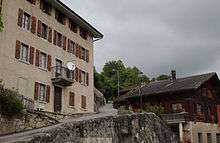
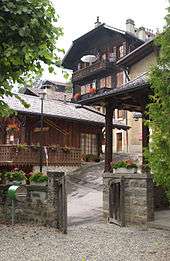
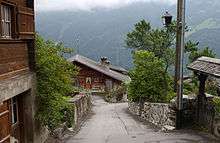
Gryon has a population (as of December 2018) of 1,332.[6] As of 2008, 27.0% of the population are resident foreign nationals.[7] Over the last 10 years (1999–2009 ) the population has changed at a rate of 15.2%. It has changed at a rate of 16.1% due to migration and at a rate of 0.5% due to births and deaths.[8]
Most of the population (as of 2000) speaks French (870 or 87.6%), with German being second most common (40 or 4.0%) and English being third (32 or 3.2%). There are 19 people who speak Italian.[9]
Of the population in the municipality 280 or about 28.2% were born in Gryon and lived there in 2000. There were 310 or 31.2% who were born in the same canton, while 170 or 17.1% were born somewhere else in Switzerland, and 225 or 22.7% were born outside of Switzerland.[9]
In 2008 there were 4 live births to Swiss citizens and 4 births to non-Swiss citizens, and in same time span there were 6 deaths of Swiss citizens. Ignoring immigration and emigration, the population of Swiss citizens decreased by 2 while the foreign population increased by 4. There were 2 Swiss men who emigrated from Switzerland and 5 Swiss women who immigrated back to Switzerland. At the same time, there were 9 non-Swiss men and 9 non-Swiss women who immigrated from another country to Switzerland. The total Swiss population change in 2008 (from all sources, including moves across municipal borders) was a decrease of 15 and the non-Swiss population increased by 30 people. This represents a population growth rate of 1.3%.[7]
The age distribution, as of 2009, in Gryon is; 132 children or 11.2% of the population are between 0 and 9 years old and 117 teenagers or 9.9% are between 10 and 19. Of the adult population, 113 people or 9.6% of the population are between 20 and 29 years old. 167 people or 14.2% are between 30 and 39, 183 people or 15.5% are between 40 and 49, and 144 people or 12.2% are between 50 and 59. The senior population distribution is 178 people or 15.1% of the population are between 60 and 69 years old, 86 people or 7.3% are between 70 and 79,there are 49 people or 4.2% who are 80 and 89, and there are 11 people or 0.9% who are 90 and older.[10]
As of 2000, there were 358 people who were single and never married in the municipality. There were 511 married individuals, 56 widows or widowers and 68 individuals who are divorced.[9]
As of 2000, there were 459 private households in the municipality, and an average of 2.1 persons per household.[8] There were 177 households that consist of only one person and 23 households with five or more people. Out of a total of 473 households that answered this question, 37.4% were households made up of just one person and there was 1 adult who lived with their parents. Of the rest of the households, there are 148 married couples without children, 113 married couples with children There were 14 single parents with a child or children. There were 6 households that were made up of unrelated people and 14 households that were made up of some sort of institution or another collective housing.[9]
In 2000 there were 709 single family homes (or 72.1% of the total) out of a total of 983 inhabited buildings. There were 205 multi-family buildings (20.9%), along with 30 multi-purpose buildings that were mostly used for housing (3.1%) and 39 other use buildings (commercial or industrial) that also had some housing (4.0%). Of the single family homes 104 were built before 1919, while 42 were built between 1990 and 2000. The greatest number of single family homes (166) were built between 1961 and 1970. The most multi-family homes (52) were built between 1971 and 1980 and the next most (51) were built between 1981 and 1990.[11]
In 2000 there were 1,765 apartments in the municipality. The most common apartment size was 3 rooms of which there were 439. There were 184 single room apartments and 384 apartments with five or more rooms. Of these apartments, a total of 449 apartments (25.4% of the total) were permanently occupied, while 1,231 apartments (69.7%) were seasonally occupied and 85 apartments (4.8%) were empty.[11] As of 2009, the construction rate of new housing units was 11.8 new units per 1000 residents.[8] The vacancy rate for the municipality, in 2010, was 2.01%.[8]
The historical population is given in the following chart:[3][12]

Sights
The entire village of Gryon and the Taveyanne area are designated as part of the Inventory of Swiss Heritage Sites[13]
Politics
In the 2007 federal election the most popular party was the SVP which received 23% of the vote. The next three most popular parties were the FDP (22.05%), the SP (15.46%) and the Green Party (12.76%). In the federal election, a total of 283 votes were cast, and the voter turnout was 41.0%.[14]
Economy
As of 2010, Gryon had an unemployment rate of 4.8%. As of 2008, there were 19 people employed in the primary economic sector and about 7 businesses involved in this sector. 92 people were employed in the secondary sector and there were 17 businesses in this sector. 204 people were employed in the tertiary sector, with 43 businesses in this sector.[8] There were 475 residents of the municipality who were employed in some capacity, of which females made up 42.9% of the workforce.
In 2008 the total number of full-time equivalent jobs was 256. The number of jobs in the primary sector was 9, all of which were in agriculture. The number of jobs in the secondary sector was 85 of which 35 or (41.2%) were in manufacturing and 50 (58.8%) were in construction. The number of jobs in the tertiary sector was 162. In the tertiary sector; 39 or 24.1% were in wholesale or retail sales or the repair of motor vehicles, 3 or 1.9% were in the movement and storage of goods, 36 or 22.2% were in a hotel or restaurant, 4 or 2.5% were technical professionals or scientists, 29 or 17.9% were in education and 18 or 11.1% were in health care.[15]
In 2000, there were 53 workers who commuted into the municipality and 256 workers who commuted away. The municipality is a net exporter of workers, with about 4.8 workers leaving the municipality for every one entering.[16] Of the working population, 11.8% used public transportation to get to work, and 65.3% used a private car.[8]
Religion
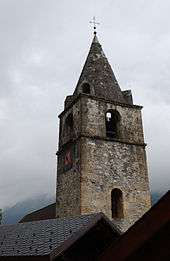
From the 2000 census, 254 or 25.6% were Roman Catholic, while 524 or 52.8% belonged to the Swiss Reformed Church. Of the rest of the population, there were 9 members of an Orthodox church (or about 0.91% of the population), and there were 15 individuals (or about 1.51% of the population) who belonged to another Christian church. There were 12 (or about 1.21% of the population) who were Islamic. There were and 4 individuals who belonged to another church. 153 (or about 15.41% of the population) belonged to no church, are agnostic or atheist, and 22 individuals (or about 2.22% of the population) did not answer the question.[9]
Weather
Gryon has an average of 139.4 days of rain or snow per year and on average receives 1,367 mm (53.8 in) of precipitation. The wettest month is June during which time Gryon receives an average of 134 mm (5.3 in) of rain or snow. During this month there is precipitation for an average of 13.9 days. The month with the most days of precipitation is May, with an average of 13.9, but with only 120 mm (4.7 in) of rain or snow. The driest month of the year is October with an average of 94 mm (3.7 in) of precipitation over 9 days.[17]
Education
In Gryon about 387 or (39.0%) of the population have completed non-mandatory upper secondary education, and 160 or (16.1%) have completed additional higher education (either university or a Fachhochschule). Of the 160 who completed tertiary schooling, 42.5% were Swiss men, 25.6% were Swiss women, 16.9% were non-Swiss men and 15.0% were non-Swiss women.[9]
In the 2009/2010 school year there were a total of 111 students in the Gryon school district. In the Vaud cantonal school system, two years of non-obligatory pre-school are provided by the political districts.[18] During the school year, the district provided pre-school care for a total of 205 children of which 96 children (46.8%) received subsidized pre-school care. There were 70 students in the primary school program, which lasts four years. The obligatory lower secondary school program lasts for six years and there were 41 students in those schools.[19]
As of 2000, there were 27 students in Gryon who came from another municipality, while 83 residents attended schools outside the municipality.[16]
References
- "Arealstatistik Standard - Gemeinden nach 4 Hauptbereichen". Federal Statistical Office. Retrieved 13 January 2019.
- "Ständige Wohnbevölkerung nach Staatsangehörigkeitskategorie Geschlecht und Gemeinde; Provisorische Jahresergebnisse; 2018". Federal Statistical Office. 9 April 2019. Retrieved 11 April 2019.
- Gryon in German, French and Italian in the online Historical Dictionary of Switzerland.
- Swiss Federal Statistical Office-Land Use Statistics 2009 data (in German) accessed 25 March 2010
- Flags of the World.com accessed 3 May 2011
- Swiss Federal Statistical Office - STAT-TAB, online database – Ständige und nichtständige Wohnbevölkerung nach institutionellen Gliederungen, Geburtsort und Staatsangehörigkeit (in German) accessed 23 September 2019
- Swiss Federal Statistical Office - Superweb database - Gemeinde Statistics 1981-2008 Archived 28 June 2010 at the Wayback Machine (in German) accessed 19 June 2010
- Swiss Federal Statistical Office Archived 5 January 2016 at the Wayback Machine accessed 3 May 2011
- STAT-TAB Datenwürfel für Thema 40.3 - 2000 Archived 9 April 2014 at the Wayback Machine (in German) accessed 2 February 2011
- Canton of Vaud Statistical Office (in French) accessed 29 April 2011
- Swiss Federal Statistical Office STAT-TAB - Datenwürfel für Thema 09.2 - Gebäude und Wohnungen Archived 7 September 2014 at the Wayback Machine (in German) accessed 28 January 2011
- Swiss Federal Statistical Office STAT-TAB Bevölkerungsentwicklung nach Region, 1850-2000 Archived 30 September 2014 at the Wayback Machine (in German) accessed 29 January 2011
- "Kantonsliste A-Objekte". KGS Inventar (in German). Federal Office of Civil Protection. 2009. Archived from the original on 28 June 2010. Retrieved 25 April 2011.
- Swiss Federal Statistical Office, Nationalratswahlen 2007: Stärke der Parteien und Wahlbeteiligung, nach Gemeinden/Bezirk/Canton Archived 14 May 2015 at the Wayback Machine (in German) accessed 28 May 2010
- Swiss Federal Statistical Office STAT-TAB Betriebszählung: Arbeitsstätten nach Gemeinde und NOGA 2008 (Abschnitte), Sektoren 1-3 Archived 25 December 2014 at the Wayback Machine (in German) accessed 28 January 2011
- Swiss Federal Statistical Office - Statweb (in German) accessed 24 June 2010
- "Temperature and Precipitation Average Values-Table, 1961-1990" (in German, French, and Italian). Federal Office of Meteorology and Climatology - MeteoSwiss. Archived from the original on 27 June 2009. Retrieved 8 May 2009., the Gryon weather station elevation is 1085 meters above sea level.
- Organigramme de l'école vaudoise, année scolaire 2009-2010 (in French) accessed 2 May 2011
- Canton of Vaud Statistical Office - Scol. obligatoire/filières de transition (in French) accessed 2 May 2011
| Wikimedia Commons has media related to Gryon. |